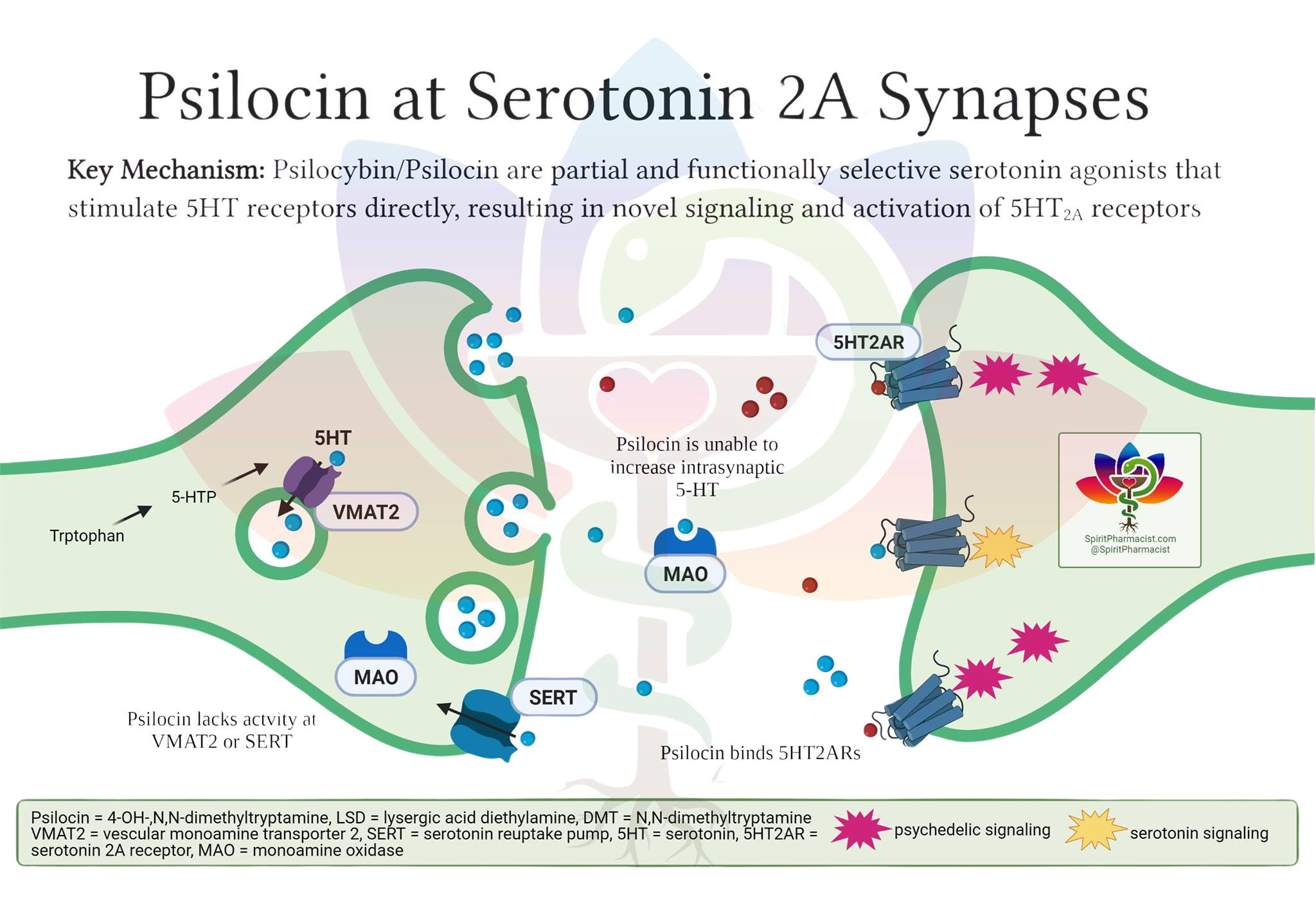MDMA is different than Psilocybin, but how?
It feels appropriate to write about the love drug known as MDMA on Valentine’s Day!
Information about both MDMA’s and Psilocybin’s ability to support symptoms of depression and boost serotonin is widely circulating. Although some effects can be similar, they actually don’t behave the same way.
Here is a brief overview of how they differ mechanistically.
First, serotonin!
Serotonin (5HT), is often referred to as a "feel-good" neurotransmitter. It plays a role in regulating mood, anxiety, and happiness among other physiological functions.
Serotonin receptors are found throughout the body, with significant concentrations in the central nervous system (CNS), including in the brain and spinal cord, where they play key roles in mood regulation, cognition, and pain perception. These receptors are also prevalent in the peripheral nervous system and various peripheral tissues. In the gastrointestinal tract, serotonin is crucial for regulating motility and secretion, reflecting its nickname as the "gut's brain." Approximately 90% of serotonin receptors are found here. Additionally, serotonin receptors in blood vessels, platelets, the heart, and lungs influence blood pressure, clotting, heart function, and respiratory regulation. The receptors are classified into several subtypes, such as 5-HT1 to 5-HT7, each with specific distributions and functions, highlighting serotonin's broad impact on both physiological and psychological processes.
Psilocybin is an agonist of serotonin receptors (5HT-R).
This means that Psilocybin binds to 5HT-R and induces a positive biological effect: serotonin release.
Think of this as a lock and key mechanism. Typically, serotonin (5HT), the key, will bind to its own receptors (5Ht-R), the lock. Psilocybin is a key that also fits into this same serotonin lock. When the door opens, serotonin is released.
MDMA, on the other hand, is not a direct agonist of 5HT-R, but does increase serotonin.
MDMA is not a key that fits into this lock. MDMA affects the transporters that are responsible for capturing serotonin to take it back into the cells for storage. These transporters are called SERT. By inhibiting SERT, more serotonin is available to bind to their receptors. MDMA can also cause more serotonin to be released into the presynaptic cleft, saturating the receptors and amplifying the effect of the neurotransmitters.
MDMA also inhibits the Monoamine Oxidase enzyme, which is responsible for breaking down and metabolizing serotonin. By blocking its metabolism, more serotonin is again available for binding. This is why MDMA can be contraindicated for individuals who take antidepressants of the MAOI class (Monoamine Oxidase Inhibitors). Both of these taken together could amplify the inhibitory effect on the MAO enzyme, creating too much serotonin availability, potentially leading to Serotonin Syndrome. This risk also exists for combined use of Psilocybin and MAOIs, as serotonin is not being appropriately metabolised.
Serotonin syndrome is a potentially life-threatening condition resulting from excessive serotonin levels in the nervous system, often due to medication interactions or overdose. Symptoms can range from mild (shivering, diarrhea) to severe (muscle rigidity, fever, seizures).
MDMA doesn’t only affect serotonin, but also the dopamine and norepinephrine transmitters. While, Psilocybin specifically acts on serotonin, MDMA has a broader effect. This non-specificity for neurotransmitters is an important reason why MDMA is showing so much promise for PTSD therapy. Dopaminergic activity helps enhance mood and emotional engagement, which are vital for therapeutic processes. Dopamine release during MDMA sessions can improve openness and emotional connection, facilitating the therapeutic exploration of traumatic memories and the development of positive associations, thus aiding in the healing process.
MDMA increases the release of norepinephrine as well, which affects energy levels and arousal. This increase can heighten emotional responses and physical sensations, potentially enhancing the therapeutic experience by allowing deeper emotional processing during PTSD therapy sessions. But it is also the reason by you may feel your heart beat increase and your body temperature rise.
SSRIs and MDMA
When SSRIs are taken concurrently with MDMA, the SSRI's blockade of the serotonin reuptake transporter can inhibit MDMA's ability to release serotonin into the synaptic cleft. Since SSRIs occupy these transporters to prevent reuptake of serotonin, they can also prevent MDMA from accessing these transporters to release serotonin. This can lead to a reduction in the subjective effects of MDMA, as the primary mechanism through which MDMA exerts its effects (serotonin release) is impeded.
SSRIs and Psilocybin
Due to psilocybin’s mechanism of direct 5HT-R agonism (key and lock), combined use with the SSRI class of antidepressants causes a dampening effect, rather than an amplifying effect. It has been noted that those utilizing psilocybin in therapy, may need to take a larger dose to feel its effect, if they are also taking prescription SSRIs.
SSRI stands for Selective Serotonin Reuptake Inhibitor.
This class of antidepressants block the reuptake of serotonin into the cells, leading to a greater amount of serotonin available for binding to + saturating their receptors. This leaves less receptors available for psilocybin to bind to. When SSRIs are present, the competition or receptor down-regulation might diminish psilocybin's efficacy, potentially leading to a blunted psychedelic experience.
Recreation and Couple’s Therapy
MDMA has been used in recreational settings as well as in underground couple’s therapy. It is known as an empathogen and for its heart opening effects. From the dance floor to an intimate night in, MDMA fosters feelings of joy, love, and euphoria. It may make you dance extra hard and put a big smile on your face, but it can also support navigating trying times between romantic partners by promoting trust, acceptance, and openness to share.
MDMA and The FDA
Recently, the MAPS organization filed a New Drug Application (NDA) with the FDA for the treatment of PTSD with MDMA Therapy. This NDA was recently accepted and the approval for this breakthrough therapy should be reviewed by August 2024. MAPS was established in the 1980’s with this very objective in mind. After being told countless times that this day would never come, MAPS founder, Rick Doblin, must be over the moon to be this close to approval after so many years of work.
—
I’m hopeful for the future of both PTSD and couple’s therapy. I urge those using MDMA in underground settings, be it for therapy or recreation, to practice safety first.
On this 2024 Valentine’s, practice self-love, acceptance, and openness.
—
For more about MDMA and MAPS
https://doubleblindmag.com/lykos-therapeutics-maps/
https://doubleblindmag.com/mdma-maps-study-phase-3/
https://www.nature.com/articles/s41591-021-01336-3
https://doubleblindmag.com/mdma-what-is-molly/
https://www.spiritpharmacist.com/blog/is-mdma-neurotoxic
Images provided by Spirit Pharmacist


